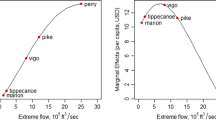Abstract
Efforts to measure people’s responses to spatially delineated risks confront the potential for correlation between these risks and other, unobserved characteristics of these locations. The possibility of correlation arises in part because individuals observe other locational attributes that can be expected to influence the hedonic equilibrium. One response to this problem is to use events from nature to exploit both temporal and spatial variation in the behavioral responses of interest. This paper evaluates the use of hurricanes as a source of new risk information to households in coastal counties potentially subject to the effects of these storms. We study the extent to which housing prices before and after hurricane Andrew, a hurricane with unprecedented property loss, reveal how Floridians responded to the risk information provided by the storm. Two counties are selected – one without and another with damage from the hurricane. To evaluate the plausibility of using quasi-random experiments for locations not directly affected by natural events, we compare Lee County’s results to those of Dade County, where the majority of the damage occurred. Our findings suggest, after controlling for ex post storm damage and changes in insurance markets, there is a reasonably high level of consistency in a repeat sales model’s ability to estimate the effects of the risk information conveyed by the storm for both counties.
Similar content being viewed by others
References
AIR Worldwide Corporation, 2002, ‘Ten Years after Andrew: What Should We Be Preparing for Now?’ AIR Special Report, Technical Document_HASR_0208, August.
K. J. Beron C. M. James M. A. Thayer W. P. M. Vijverberg (1997) ArticleTitle‘An Analysis of the Housing Market Before and After the 1989 Loma Prieta Earthquake’ Land Economics 73 IssueID1 101–113
K. Y. Chay M. Greenstone (2003) ArticleTitle‘The Impact of Air Pollution on Infant Mortality: Evidence from Geographic Variation in Pollution Shocks Induced by a Recession’ Quarterly Journal of Economics 118 IssueIDAugust 1121–1167
K. Y. Chay M. Greenstone (2005) ArticleTitle‘Does Air Quality Matter? Evidence from the Housing Market’ Journal of Political Economy 113 IssueIDApril 376–424
J. Chivers N. E. Flores (2002) ArticleTitle‘Market Failure in Information: The National Flood Insurance Program’ Land Economics 78 IssueID4 515–521
I. Ekeland J. J. Heckman L. Nesheim (2004) ArticleTitle‘Identification and Estimation of Hedonic Models’ Journal of Political Economy 112 IssueIDFebruary S60–S109
S. B. Goldenberg C. W. Landsea A. M. Mestas-Nuñez W. M. Gray (2001) ArticleTitle‘The Recent Increase in Atlantic Hurricane Activity: Causes and Implications’ Science 293 IssueIDJuly 475–479
Hallstrom Daniel G. and V. Kerry Smith (2005), ‘Market Responses to Hurricanes’. Journal of Environmental Economics and Management 50 (November) 541–562.
J. J. Heckman (1979) ArticleTitle‘Sample Selection Bias as a Specification Error’ Econometrica 47 IssueIDJanuary 153–161
Huber P. J. (1967), ‘The Behavior of Maximum Likelihood Estimates under Non-Standard Conditions’, in: Proceedings of the Fifth Symposium on Mathematical Statistics and Probability. Berkeley. CA: University of California Press.
T. R. Knutson R. E. Tuleya Y. Kurihara (1998) ArticleTitle‘Simulated Increase of Hurricane Intensities in a CO2-Warmed Climate’ Science 279 IssueIDFebruary 1018–1020
Lewis R. C. (2005), ‘Insurers drop coastal homes: Hurricane Andrew a key – its claims were 4 times higher than other storms’. News & Observer, (March 27).
P. Longman (1994) ArticleTitle‘The Politics of Wind’ Florida Trend 37 IssueID5 30–39
R. Mendelsohn D. Hellerstein M. Huguenin R. Unsworth R. Brayee (1992) ArticleTitle‘Measuring Hazardous Waste Damages with Panel Models’ Journal of Environmental Economics and Management 22 IssueIDMay 259–271
B. D. Meyer (1995) ArticleTitle‘Natural and Quasi-Experiments in Economics’ Journal of Business and Economic Statistics 12 IssueIDApril 151–161
R. B. Palmquist (1982) ArticleTitle‘Measuring Environmental Effects on Property Values without Hedonic Regressions’ Journal of Urban Economics 11 IssueID3 333–347 Occurrence Handle10.1016/0094-1190(82)90079-1
Rappaport (ed.) (1993). Hurricane Andrew 16–28 August, 1992. Preliminary Report, National Hurricane Center, December.
S. Rosen (1974) ArticleTitle‘Hedonic Prices and Implicit Markets: Product Differentiation in Perfect Competition’ Journal of Political Economy 82 IssueIDFebruary 34–55
M. R. Rosenzweig K. I. Wolpin (2000) ArticleTitle‘Natural “Natural Experiments” in Economics’ Journal of Economic Literature 38 IssueIDDecember 827–874
J. F. Shogren T. D. Crocker (1991) ArticleTitle‘Risk, Self-Protection, and Ex Ante Economic Value’ Journal of Environmental Economics and Management 20 IssueIDJanuary 1–15
J. F. Shogren T. D. Crocker (1999) ArticleTitle‘Risk and Its Consequences’ Journal of Environmental Economics and Management 37 IssueIDJanuary 44–51
Smith V. K., J. C. Carbone, D. G. Hallstrom, J. C. Pope and M. E. Darden (2005), ‘Adjusting to Natural Disasters’, unpublished CEnREP working paper, March 1.
Timmins, C. (2003), ‘Endogenous Land Use and the Ricardian Valuation of Climate Change’, Unpublished Paper, Department of Economics, Yale University, March.
R. M. Wakimoto P. G. Black (1994) ArticleTitle‘Damage Survey of Hurricane Andrew and Its Relationship to the Eyewall’ Bulletin of the American Meteorological Society 75 IssueIDFebruary 189–200
Author information
Authors and Affiliations
Corresponding author
Additional information
Department of Economics, Williams College, Affiliated Economist, CEnREP, North Carolina State University and University Distinguished Professor, North Carolina State University, and Resources for the Future University Fellow, respectively. Senior authorship is not assigned. Thanks are due to Shelby Gerking and two anonymous reviewers for careful and constructive comments that substantially improved the paper. Michael Darden and Jaren Pope provided excellent research assistance and Alex Boutaud and Susan Hinton helped to make sense out of numerous drafts of this work. Smith’s contribution was partially supported by the United States Department of Homeland Security through the Center for Risk and Economic Analysis of Terrorism Events (CREATE), grant number EMW-2004-GR-0112. However, any opinion, findings, and conclusions or recommendations in this document are those of the author(s) and do not necessarily reflect views of the U.S. Department of Homeland Security.
Rights and permissions
About this article
Cite this article
Carbone, J.C., Hallstrom, D.G. & Smith, V.K. Can Natural Experiments Measure Behavioral Responses to Environmental Risks?. Environ Resource Econ 33, 273–297 (2006). https://doi.org/10.1007/s10640-005-3610-4
Accepted:
Issue Date:
DOI: https://doi.org/10.1007/s10640-005-3610-4




